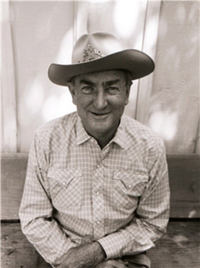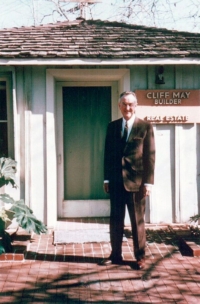By Vonn Marie May
 The California Ranch architectural style was masterfully shaped by designer Cliff May as a blend of American mid-century modern and the “Californios” hacienda. A sixth-generation Californian, Clifford Magee May grew up in San Diego County with his parents Beatrice Magee May and Charles Clifford May among many Hispanic relatives on his mother’s side. He once remarked, “With ten relatives’ homes and Aunt Jane’s … we were just on the move all the time.” May’s childhood memories of his Aunt Jane Pedrorena Magee’s ranch at Santa Margarita y Las Flores (now Camp Pendleton) and of his other ancestral home, Casa Estudillo in Old Town San Diego State Historic Park, were the most vivid impressions of early residential settings that would later inform his architectural style. In his twenties he first became an accomplished furniture maker in the Mission Revival and Monterey styles, a direct reflection of the culture of his maternal relatives.
The California Ranch architectural style was masterfully shaped by designer Cliff May as a blend of American mid-century modern and the “Californios” hacienda. A sixth-generation Californian, Clifford Magee May grew up in San Diego County with his parents Beatrice Magee May and Charles Clifford May among many Hispanic relatives on his mother’s side. He once remarked, “With ten relatives’ homes and Aunt Jane’s … we were just on the move all the time.” May’s childhood memories of his Aunt Jane Pedrorena Magee’s ranch at Santa Margarita y Las Flores (now Camp Pendleton) and of his other ancestral home, Casa Estudillo in Old Town San Diego State Historic Park, were the most vivid impressions of early residential settings that would later inform his architectural style. In his twenties he first became an accomplished furniture maker in the Mission Revival and Monterey styles, a direct reflection of the culture of his maternal relatives.
The man recognized by the City of San Diego as a Master Architect didn’t set out to be an architect — May had no formal training and never held a license to practice architecture. During the Depression he had the opportunity to furnish and stage slow-selling model homes with his furniture. The experience gave him the inspiration and the confidence to enter the field of architecture knowing he could design and build a far better housing product than what was being offered at the time. In 1931 May’s first ‘speculative’ design/build house in the neighborhood of Talmadge was the O’Leary residence, which is still extant. The ‘hacienda’ style single-story red clay tile roof, in a ‘U’ shaped floor plan was written up in the San Diego Union, which noted its central courtyard “with its flowers and wishing well gives a flavor of early California to the house.”
 From there May seemed to always be in the right place at the right time. The revered civic visionary and philanthropist George White Marston was developing the Presidio Hills housing tract contiguous to one of his most significant projects, the Junipero Serra Museum and Presidio Park. Marston was known to attract and underwrite the best design talent not just in San Diego but from around the country. He offered yet another breakthrough opportunity to May: “pick out any lot you want, and it’s yours, provided you build a house on it.” May ended up designing five homes in
From there May seemed to always be in the right place at the right time. The revered civic visionary and philanthropist George White Marston was developing the Presidio Hills housing tract contiguous to one of his most significant projects, the Junipero Serra Museum and Presidio Park. Marston was known to attract and underwrite the best design talent not just in San Diego but from around the country. He offered yet another breakthrough opportunity to May: “pick out any lot you want, and it’s yours, provided you build a house on it.” May ended up designing five homes in
May’s early body of work in San Diego County spanned a mere seven years from 1931-1937. He completed some fifty ‘built-for-sale’ speculative houses as well as a few custom homes. It is evident that San Diego is where he found his style, refined his craft, and worked alongside other deeply committed experimental designers and builders of the day. In yet another twist-of-fate May was lured to Los Angeles by housing developers in a robust development market. For the next fifty years May cultivated his personal and professional life there with great success.
As a sixth-generation native son, born and bred in San Diego County, Cliff May contributed to the American architectural landscape his entire professional life. He is lauded as an architectural master primarily for his cultural prototype, the California Ranch House, conceived and developed in San Diego and later spread across the nation. As an American with deep Hispanic roots his modern indigenous design style of architecture is commensurate to that of the Midwest Prairie style, another truly American invention. May’s ‘lifestyle’ designs and his subsequent influence on mass produced affordable housing responded to culture, nature, and functional sensibilities and have continued to stand the test of time.

The home of Cliff May’s aunt, Jane Pedrorena Magee, at Rancho Santa Margarita y Las Flores (now Camp Pendleton) – From: Las Flores Adobe National Historic Landmark Cultural Landscape Initial Study, by Vonn Marie May and Laura Burnett
Editor’s Note: As far as is known at this writing, there is no kin relationship between Clifford Magee May and our author, Vonn Marie May.
Sources:
Bricker, David: Toward a Simpler Life: The Arts and Crafts Architects of California, Cliff May; University of California Press, Berkeley, Los Angeles, London, 1997
Hess, Alan: The Ranch House; Harry N. Abrams, Inc. Publishers, New York, 2004
Johnson, Paul C., Editor: Western Ranch Houses by Cliff May; Sunset Magazine and Books, Hennessey + Ingalls, Santa Monica, 1997
Laskey, Marlene L., Interviewer: The California Ranch House – Cliff May; Oral History Program UCLA, The Regents of the University of California, 1984
May, Vonn Marie; and Laura Burnett: Las Flores Adobe National Historic Landmark Cultural Landscape Initial Study; University of Vermont, 2012
Spiller, Virginia: “Cliff May: Home designer dies, Architect, Cliff May dies at 81” – San Diego Union, 21 October 1989
Images:
Cliff May (circa mid-1980’s–Photo from Getty, via Joe Barthlow
Cliff May in front of his office at Riviera Ranch in Los Angeles, 1970 via Mary A. van Balgooy
